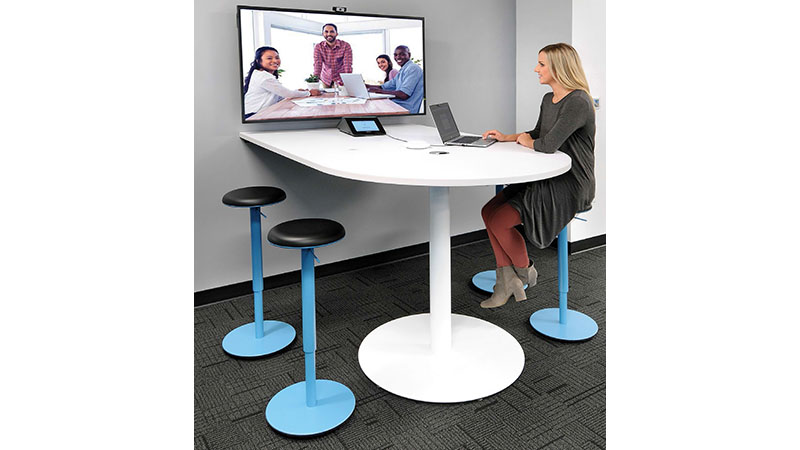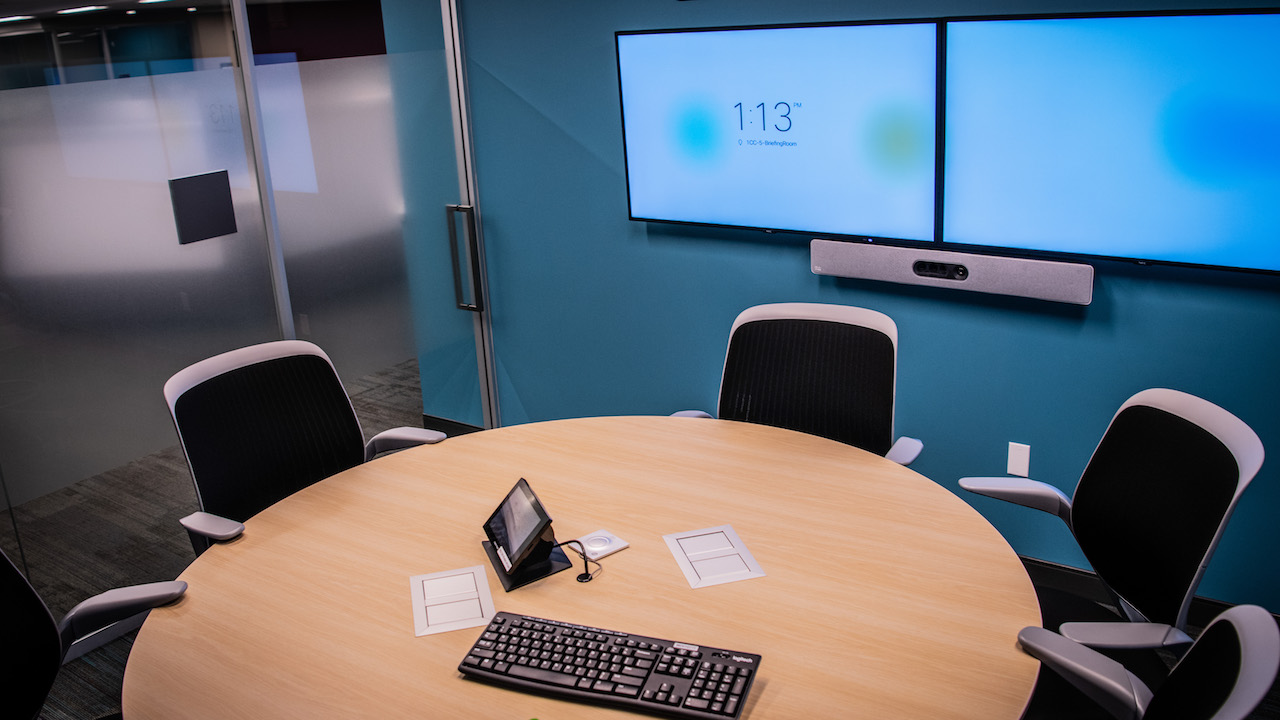State of the Huddle Space
It’s important to make sure huddle spaces are capable of many things. We explore how to roll out—and refresh—these facilities to obtain optimum adoption and return on investment.

According to research firm Frost & Sullivan, there are more than 32 million huddle rooms deployed globally. By 2022, the firm projects that 70 percent of all videoconferencing meetings will take place in a huddle room. With business professionals embracing the concept of the ad hoc meeting, tech managers must continue to explore how to roll out—and refresh—these facilities to obtain optimum adoption and return on investment.
One of the best ways toward achieving this is gaining insight into when and how spaces are being used, and by whom. Matt Boyer, director of technology at Vistacom, an AV design and integration firm headquartered in Allentown, PA, noted that room analytics and scheduling functionality not only helps users locate available meeting space, they also provide tech managers with valuable information that can influence future buying decisions.
“[Users] can get access to those rooms on an ad hoc basis by having some kind of scheduling panel outside the room, where they can find an available room, see how long it’s going to be available, and then book it right on the spot,” he said. This functionality lets "technology managers know how often the rooms are booked, and which rooms are booked in a particular area.” He added that scheduling capabilities have extended to hot-desking: “[They help] people coming in from the field to find and book a desk when they come into the office.”

From Vistacom’s vantage point, some organizations are beginning to equip their huddle spaces—or at least a portion thereof—with advanced collaboration systems. “It’s not just a simple display in the room, but actual collaboration platforms [that allow] people to interact with people in the room and outside of the room,” he said.
He relayed that his firm deploys a significant number of Prysm systems to provide more sophisticated collaboration capabilities to professionals in need of them. “These are certainly not in all of the huddle rooms, but specific [spaces] have those appliances in them. The large conference rooms are going away in lieu of these smaller conference rooms, so that technology is starting to filter into them.”

When outfitting these spaces, Boyer urges tech managers to prioritize audio systems that take remote meeting participants into account. “The number one thing that makes or breaks a meeting as far as it being successful is audio. You can have an elaborate conferencing and collaboration tool but if there is poor audio, the people on the far end can’t hear clearly,” he said. “[It’s important] to have a permanent, higher-quality audio device in there—whether it’s a USB speakerphone or something like a Polycom Trio, which is very effective in huddle rooms—to provide that enhanced audio capability.” He added that video is great for meetings, but without good audio, it’s difficult for team members to share ideas with one another.
Standardization should also be a top priority, in view of the fact that many organizations deploy hundreds, or even thousands, of these facilities. While certain huddle spaces may be slightly more sophisticated—such as those following Boyer’s Prysm collaboration system example—the more they remain reasonably identical, the easier they are to utilize and manage. “It’s one thing to have a custom boardroom that may take some training, but if you’re going to try and deploy them throughout your organization, a repeatable operation is important.” Otherwise, he said, companies risk low adoption levels.
A daily selection of features, industry news, and analysis for tech managers. Sign up below.

One of the challenging aspects of refreshing these spaces is dealing with the fixed elements that are already in place, noted Tom Spearman, executive vice president at Diversified, a global technologies solutions provider headquartered in Kenilworth, NJ.
“It’s very difficult to know if [certain components] are going to fit inside of the built environment because there are so many variables,” he said. The type of display, its compatibility with ancillary devices, furniture, power outlets, data drops—each has an impact on what new technology can be installed. “When you embark on a huddle room refresh project, the number-one consideration is: how can I create a solution that doesn’t require a lot of room remediation or furniture changes? Because if the conduit in the floor is already jam-packed with data cables, none of those can be used as your cable path between the flat screen and the table. The equipment piece is only part of the equation; it’s really about how to implement that equipment in an existing facility that makes these upgrade and refresh projects challenging.”

Obtaining the ability to alter the makeup of these spaces as an organization’s needs change can also present issues: what happens when a company wants to transform “static” spaces that feature little, if any, tech into more dynamic meeting spaces? Or, if it wishes to overhaul a former huddle room into a more formal meeting room?
“If you look at the corporate world, a lot of the spaces I work in right now, they will have hundreds of rooms that are relatively undefined—they’re defined in some way at the beginning of a project, but a huddle room may convert to an office and then to a meeting room in a few years,” said Rodrigo Ordonez, principal at K2 Audio, an AV design and integration firm headquartered in Boulder, CO. “It’s very difficult to do that with traditional AV technologies unless every time that happens, you basically do a construction project or a full installation redesign project.” And yet, room flexibility adds increased value to a company’s real estate.
While many large enterprises follow refresh cycles, tech managers may also want to future-proof their huddle rooms as much as possible. This isn’t always feasible, but Spearman believes that with a solid collaboration platform, futureproofing becomes somewhat of a moot point. “[Most organizations have] already made the strategic decision about what collaboration platform they want to invest in, and then everything they’re doing in the huddle rooms is focused on integrating with that standard,” he said. What’s important, he said, is choosing supporting technology that works well with your platform of choice. “I think the manufacturers have done a good job of making their technology capable of supporting multiple platforms. There are exceptions, but for the most part, the AV manufacturers are trying to stake out a position that is somewhat platform agnostic.”
Use, Don't Lose
Standardized, user-friendly huddle spaces are key to promoting adoption. AV systems integrator Vistacom offers training services that help users learn the technology that is deployed in these spaces, and how they can incorporate it into their workflow. “If they’re a big whiteboard user, for example, how do they make use of whiteboards?” said Mark Boyer, director of technology at the firm. “Or maybe they love sticky notes. Some collaboration technologies have a sticky note function [where] you don’t have to take all your [paper] sticky notes off the wall when you’re done with the room—you can just close your application and take them with you.”
Carolyn Heinze is a freelance writer/editor.
DIVERSIFIED
www.diversifiedus.com
K2 AUDIO LLC
www.thisisk2.com
VISTACOM INC.
www.vistacominc.com
Carolyn Heinze has covered everything from AV/IT and business to cowboys and cowgirls ... and the horses they love. She was the Paris contributing editor for the pan-European site Running in Heels, providing news and views on fashion, culture, and the arts for her column, “France in Your Pants.” She has also contributed critiques of foreign cinema and French politics for the politico-literary site, The New Vulgate.
